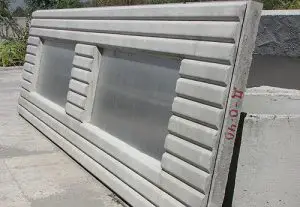Prefabricated concrete is the concrete that is produced by casting into a reusable mold or form. This type of concrete is produced away from the site and then transported to the site when needed. The production level of such concrete is of the mass production type which makes it ideal for building a large number of buildings in as little time as possible and at a reduced cost. In terms of design and construction, prefabricated concrete does provide a sense of flexibility, durability and versatility. On-site concrete on the other hand is performed at the construction site itself.
Institutions or facilities that normally utilize prefabricated concrete include Industrial plants, schools, sports facilities, museums, treatment plants and municipal service buildings among others. They can also be utilized in pipes/culverts, bridge beams, septic tanks/manholes, double Ts, architectural panels, foundation walls, hollow-core slabs and traffic barriers or retaining walls.

Benefits
There are numerous advantages of prefabricated concrete such as:
- It is easier to control the mix, curing and placement of prefabricated concrete since it is manufactured in a controlled casting environment.
- It is much easier to control and monitor the quality of the end product
- Since it is prefabricated, you can cast it regardless of the weather and still achieve the same results.
- There is minimal site impact
- It is durable and flexible and provides for an enhanced fire resistance capability.
- It provides for extreme mold and mildew resistance
- It is comfortable in that a constant temperature is realized be it in a cold or hot region.
- Owing to its versatility, numerous options are available in terms of color range, surface finishing or special shapes. In addition, owing to its mould-ability capabilities, prefabricated concrete provides designers n opportunity to copy classical details.
- Since it comprises of natural raw materials such as gravels, stones, cement and sand, prefabricated concrete is ecological. In addition, the end product can be reused or recycled.
- It cuts down on construction time. This is because no wait time is needed for the concrete to gain strength in addition to the modularity of the product which makes for quick installation.
- It is affordable since it is factory produced and maintenance and repairs are kept to a minimum.
- The costs attached to prefabricated concrete are relatively lower than the more traditional one. This is because material for a number of projects can be bought at a given time hence providing for quantity discount and low costs.
- Limited labor is required when prefabricated concrete is utilized.
- The repetition process can be maximized since a single mold can be utilized in the making of a number of copies of the same product. This in turn enables you realize more value for money.
- Since the prefabricated parts are heated thanks to accelerated curing, there is a considerable increase in strength hence helping to reduce the time that would otherwise be spent on casting the part and putting it into service.
- The durability level is at its best since it is possible control the process of prefabricating the concrete.
Much as traditional construction may be long lasting and durable as well, while at the same time managing to retain its value overtime, prefabricated concrete does help cut down on construction costs. This type of concrete is also the ideal choice for today’s fast-paced and environmentally conscious construction.
In order for prefabricated concrete to be utilized in construction, restructuring of the entire conversion construction process is needed. This is in a bid to facilitate interaction between the production planning and design phase in order to advance and speed up construction.
